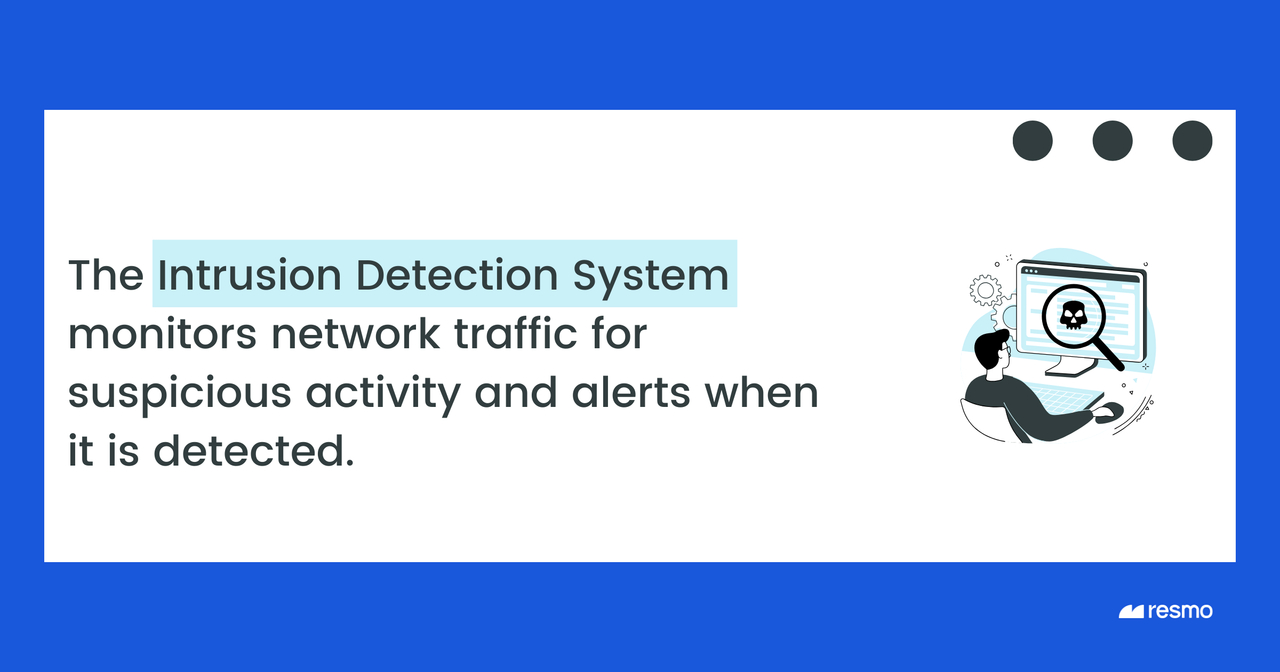
An Intrusion Detection System (IDS) is a critical cybersecurity tool designed to identify and respond to potential security threats within a network or computing environment. By monitoring network traffic and system activities, an IDS can detect suspicious or malicious behavior, helping organizations proactively defend against cyberattacks and unauthorized access.

Benefits of IDS
- Early Threat Detection: IDS provides early warning of potential security breaches, enabling swift responses to mitigate risks and limit the impact of attacks.
- Enhanced Network Visibility: IDS offers a deeper understanding of network traffic and system activities, helping identify areas of weakness and potential vulnerabilities.
- Reduced Dwell Time: By promptly detecting intrusions, IDS helps reduce dwell time—the duration that attackers remain undetected within a network.
- Compliance and Auditing: IDS assists organizations in meeting compliance requirements by monitoring and logging network activities, facilitating auditing and forensic investigations.
- Proactive Cybersecurity: IDS enables a proactive security posture, helping organizations stay ahead of emerging threats and protect critical assets and data.

Implementing IDS
Implementing an Intrusion Detection System (IDS) requires careful planning, configuration, and ongoing management to effectively detect and respond to potential security threats within a network. Below are the steps involved in implementing an IDS:
- Define Objectives and Requirements: Clearly outline the objectives of implementing the IDS. Identify the critical assets and resources to protect, the types of threats to detect, and the level of monitoring required.
- Select an IDS Solution: Choose an IDS solution that best fits your organization's needs. Consider factors such as deployment complexity, integration capabilities, scalability, and the types of detection techniques it offers.
- Choose IDS Deployment Mode: Decide whether to deploy a Network-Based IDS (NIDS), Host-Based IDS (HIDS), or a combination of both (Hybrid IDS) based on your network architecture and security requirements.
- Plan Sensor/Collector Placement: Determine where to place NIDS sensors or HIDS collectors within your network to monitor traffic effectively.
- Configure IDS Policies and Signatures: Customize the IDS policies and signatures based on your organization's security policies, compliance requirements, and known threat patterns. Regularly update signatures to keep up with emerging threats.
- Tune the IDS: Fine-tune the IDS to reduce false positives and false negatives. Adjust detection thresholds and sensitivity levels to optimize the system's accuracy and responsiveness.
- Integrate with Other Security Tools: Integrate the IDS with other security solutions like firewalls, SIEM (Security Information and Event Management) systems, and incident response platforms to enable faster and more efficient incident analysis and response.
- Establish Incident Response Procedures: Develop and document incident response procedures that outline how your organization will respond to alerts generated by the IDS. Define roles and responsibilities of incident response teams and establish clear escalation paths.
- Monitor and Review Alerts: Regularly monitor the IDS alerts to identify potential security incidents. Investigate and respond to alerts promptly, distinguishing between false positives and genuine threats.
- Conduct Regular Testing: Perform penetration testing and vulnerability assessments to validate the effectiveness of the IDS and identify potential blind spots or weaknesses in your network security.
- Training and Awareness: Train the IT staff and end-users about the importance of the IDS, how to interpret and respond to alerts, and best practices for maintaining a secure computing environment.
- Continuous Monitoring and Updates: Maintain the IDS by regularly applying software updates, security patches, and the latest threat intelligence to ensure it remains effective against evolving threats.
- Periodic Review and Evaluation: Conduct periodic reviews and evaluations of the IDS to assess its performance, identify areas for improvement, and align the system with changing security requirements.
Related Terms
Suggested Articles







